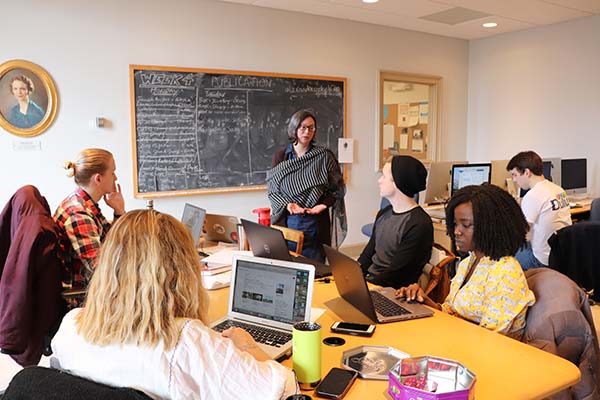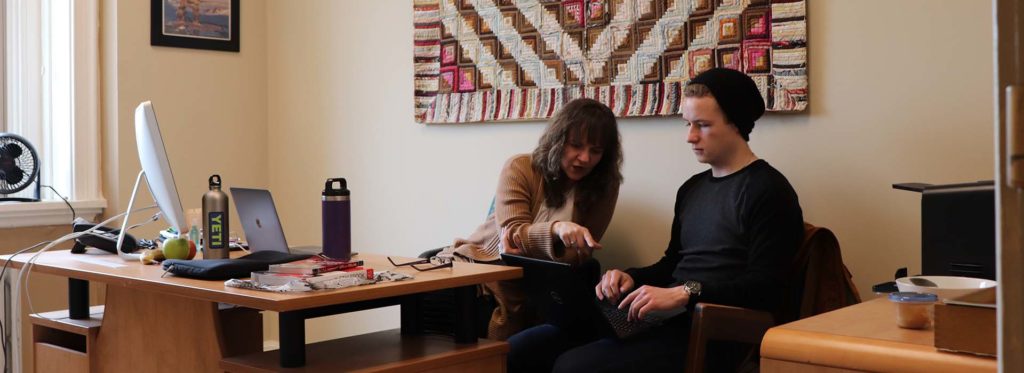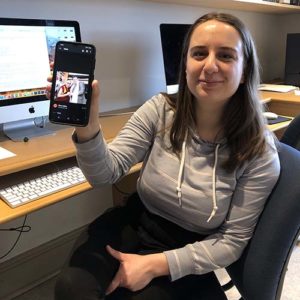At the Signal, King’s Journalism School’s media outlet, students completing the News workshop are busy breaking news and publishing stories.

Journalism Professor Terra Tailleur checks in with students while they work in the lab.
Working in a newsroom isn’t just a post-graduation dream for King’s journalism students, it’s the reality for those in their fourth-year of the Bachelor of Journalism (honours) and the Master of Journalism programs completing their News workshop, one of three workshops students take in their final year. This six-week workshop puts students in the field as they sleuth out stories, ask probing questions of community members, and advance their research and photography skills. Back in the lab, they learn to write with flair and precision for an online medium. While the outcome of each assignment, published articles on The Signal, King’s Journalism School’s award-winning media outlet, may look seamless, a lot of time, work and energy goes into each piece.
Four weeks into the winter 2020 News workshop, students start their morning by reviewing the photographs that were recently published alongside their articles in The Signal. Critiquing their photos is professional photographer Michael Creagen who, along with looking at the class’s work, brings examples into the class to showcase what other photographers are doing around the world.
I covered the memorial for the Iranian plane crash. It was a powerful experience and introduced me to a new culture and community.— Seyitan Moritiwon
After the photo critique is over, students gather around one large table for the story pitch. With everyone taking turns pitching their newest idea or giving updates on the status of their current project, classmates are quick to offer advice, contacts and encouragement. While journalism professor Terra Tailleur and workshop supervisor Yvette d’Entremont are there to lead the conversation and provide insight, the students are the ones making decisions about what stories they’ll pursue. On the docket for the next round of stories: indoor house plant care, exposing a telecommunications conspiracy, heritage buildings, flu vaccines and political drama.

Student meets with workshop supervisor Yvette d’Entremont during lab hours.
“The best part about these workshops is that they challenge me to do different types of stories that I normally wouldn’t do, like when I covered the memorial for the Iranian plane crash. It was a powerful experience and introduced me to a new culture and community. We’re always learning about and engaging with new communities all over Halifax,” says one-year Bachelor of Journalism student, Seyitan Moritiwon.
When the roundtable is over, students part ways and either go into the lab or head out to work in the field. In the lab, students dive deep into their work by calling potential sources, conducting research and collaborating with their fellow journalists. The behind-the-scenes work that goes into each piece doesn’t go unnoticed. It isn’t uncommon for an article to pick up traction online or catch the attention of a professional. Fourth-year Bachelor of Journalism student, Oliva Malley, has already had a well-known name reach out to her this year. “After I wrote an article on film photography, Bill Fitz-Patrick, the staff photographer for the United States Institute of Peace, emailed me to ask a question. He told me it was a good article!”

Oliva Malley holds photo of Bill Fitz-Patrick, the staff photographer for the United States Institute of Peace, standing to the left of the Dalai Lama.
Around noon, the lab is buzzing as students answer phones, share information and stream in and out of the space to chat with their instructors, who are just as engaged in the creative process as the students.
“This is my favourite teaching experience because these students are the real deal. They find themselves shoulder-to-shoulder with working journalists every day. They go to City Hall, the courtrooms and public engagements to cover newsworthy and interesting things that no one else is covering,” says Tailleur. “I see immense growth from week one to six. I see them become better journalists and engaged citizens. This work is exhausting and it’s not always glamorous. But the work they are doing is important and I am so proud of them.”

